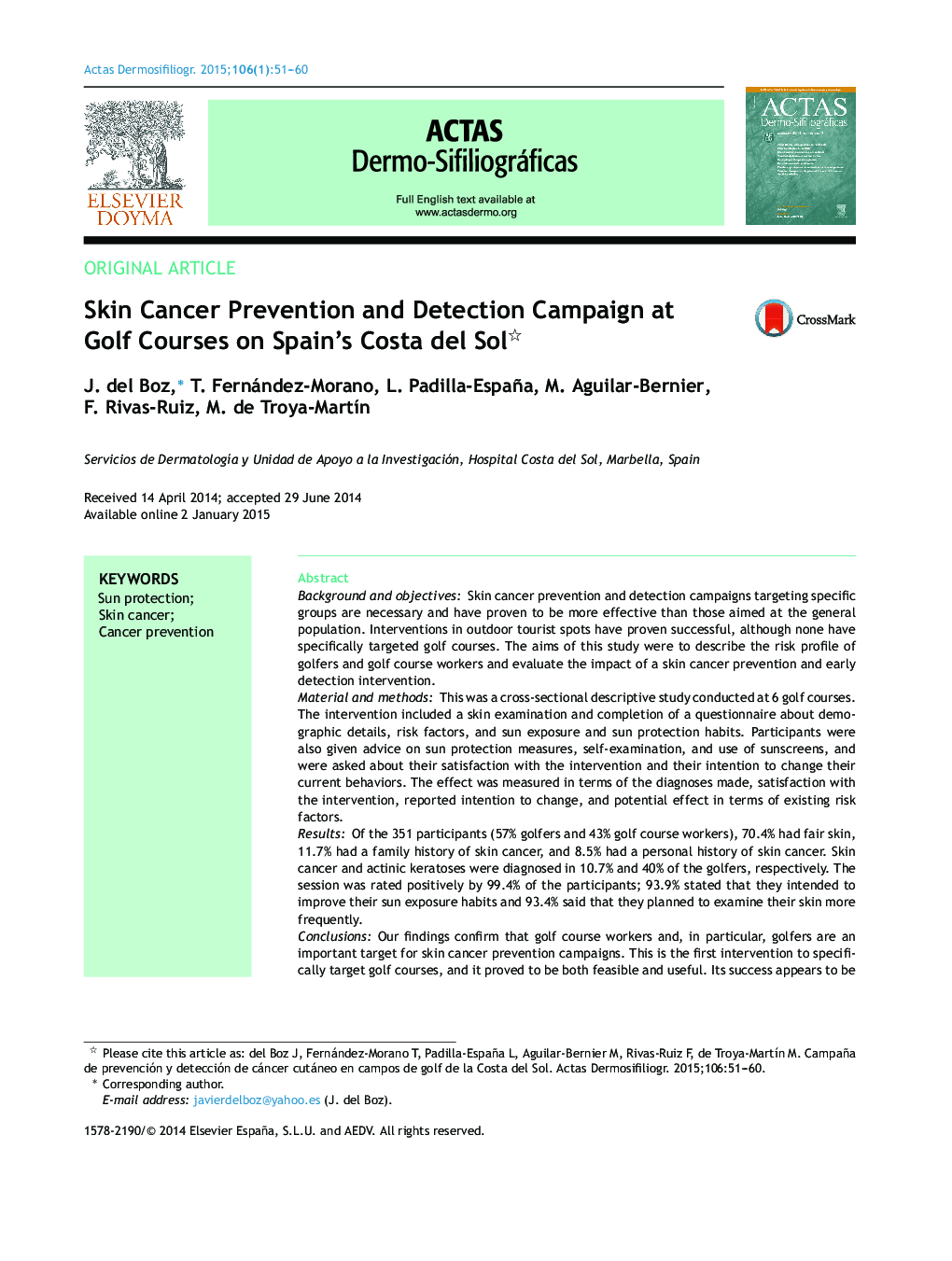| Article ID | Journal | Published Year | Pages | File Type |
|---|---|---|---|---|
| 3182980 | Actas Dermo-Sifiliográficas (English Edition) | 2015 | 10 Pages |
Background and objectivesSkin cancer prevention and detection campaigns targeting specific groups are necessary and have proven to be more effective than those aimed at the general population. Interventions in outdoor tourist spots have proven successful, although none have specifically targeted golf courses. The aims of this study were to describe the risk profile of golfers and golf course workers and evaluate the impact of a skin cancer prevention and early detection intervention.Material and methodsThis was a cross-sectional descriptive study conducted at 6 golf courses. The intervention included a skin examination and completion of a questionnaire about demographic details, risk factors, and sun exposure and sun protection habits. Participants were also given advice on sun protection measures, self-examination, and use of sunscreens, and were asked about their satisfaction with the intervention and their intention to change their current behaviors. The effect was measured in terms of the diagnoses made, satisfaction with the intervention, reported intention to change, and potential effect in terms of existing risk factors.ResultsOf the 351 participants (57% golfers and 43% golf course workers), 70.4% had fair skin, 11.7% had a family history of skin cancer, and 8.5% had a personal history of skin cancer. Skin cancer and actinic keratoses were diagnosed in 10.7% and 40% of the golfers, respectively. The session was rated positively by 99.4% of the participants; 93.9% stated that they intended to improve their sun exposure habits and 93.4% said that they planned to examine their skin more frequently.ConclusionsOur findings confirm that golf course workers and, in particular, golfers are an important target for skin cancer prevention campaigns. This is the first intervention to specifically target golf courses, and it proved to be both feasible and useful. Its success appears to be attributable to numerous factors: it was conducted at golf courses, had multiple components, and was preceded by a motivational campaign.
ResumenIntroducción y objetivosEl desarrollo de programas de prevención y detección de cáncer cutáneo específicamente dirigidos a grupos diana -de mayor rentabilidad que aquellos desarrollados sobre la población general- es necesario. Intervenciones en enclaves turísticos al aire libre ya demostraron eficacia, aunque no existen campañas específicas en campos de golf. Nuestros objetivos fueron describir el perfil de riesgo de los trabajadores y jugadores de golf y evaluar el impacto de una intervención.Material y métodosEstudio transversal descriptivo desarrollado en 6 campos de golf, realizándose cuestionarios sobre datos demográficos, factores de riesgo y hábitos de exposición solar y fotoprotección, examen cutáneo. Se impartió consejo sanitario en fotoprotección, autoexamen y cremas fotoprotectoras, y finalmente se completaron encuestas de satisfacción e intención de cambio. Se midió el efecto en términos de: diagnósticos realizados, satisfacción con la intervención e intención expresada de cambio y efecto potencial en términos de factores de riesgo presentes.ResultadosDe 351 participantes (el 57% golfistas, el resto trabajadores) el 70,4% tenían piel clara, el 11,7% tenían antecedentes familiares y el 8,5% personales de cáncer de piel. Entre los golfistas se diagnosticó cáncer cutáneo en el 10,7% y queratosis actínicas en el 40%. El 99,4% de los participantes valoró las jornadas positivamente, el 93,9% refirió intención de mejorar sus hábitos de fotoexposición y el 93,4% intención de examinarse la piel más frecuentemente.ConclusionesTrabajadores de campos de golf y especialmente golfistas se confirman como una importante diana para la prevención del cáncer cutáneo. Esta es la primera campaña dirigida a estos grupos, resultando factible y útil el desarrollo de las mismas; su éxito parece relacionado con el desarrollo en el propio escenario, la intervención multicomponente y su estrategia publicitaria motivacional.
